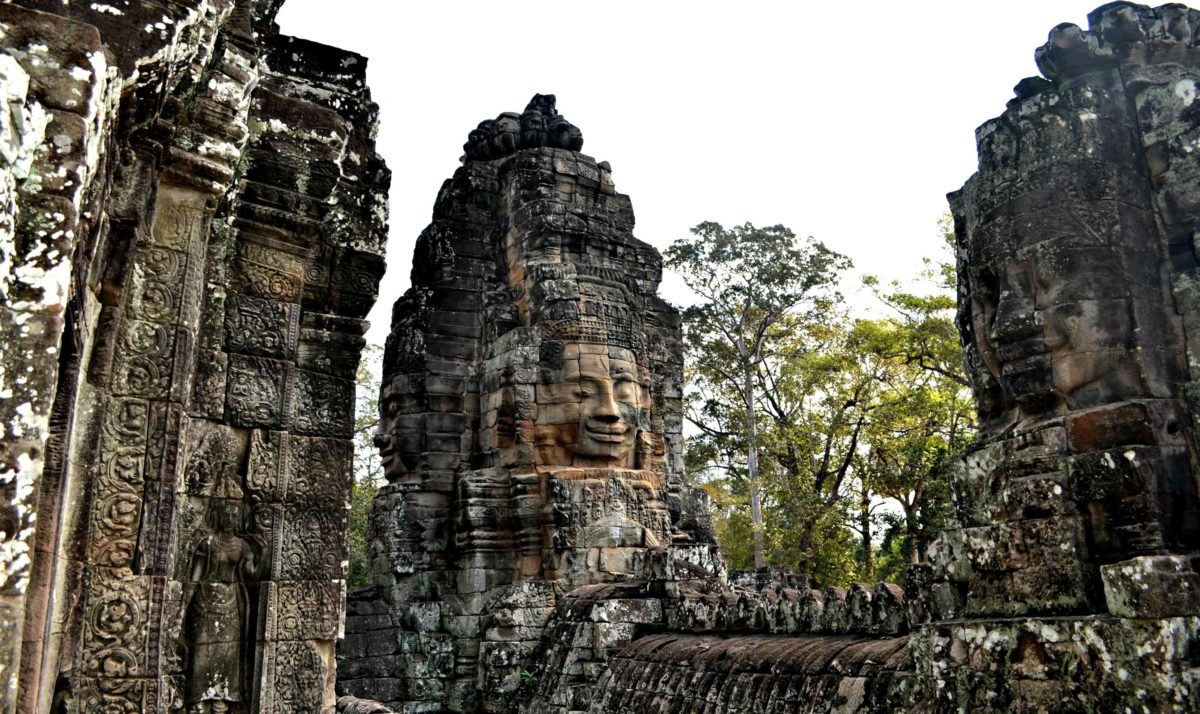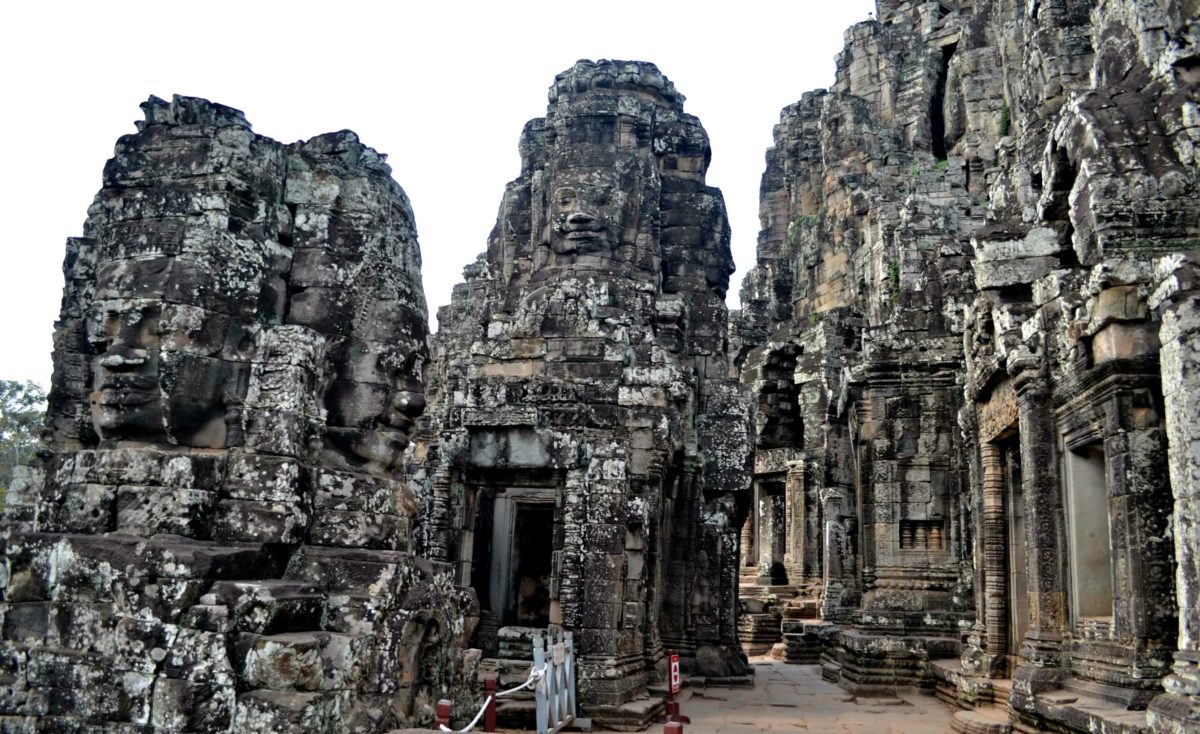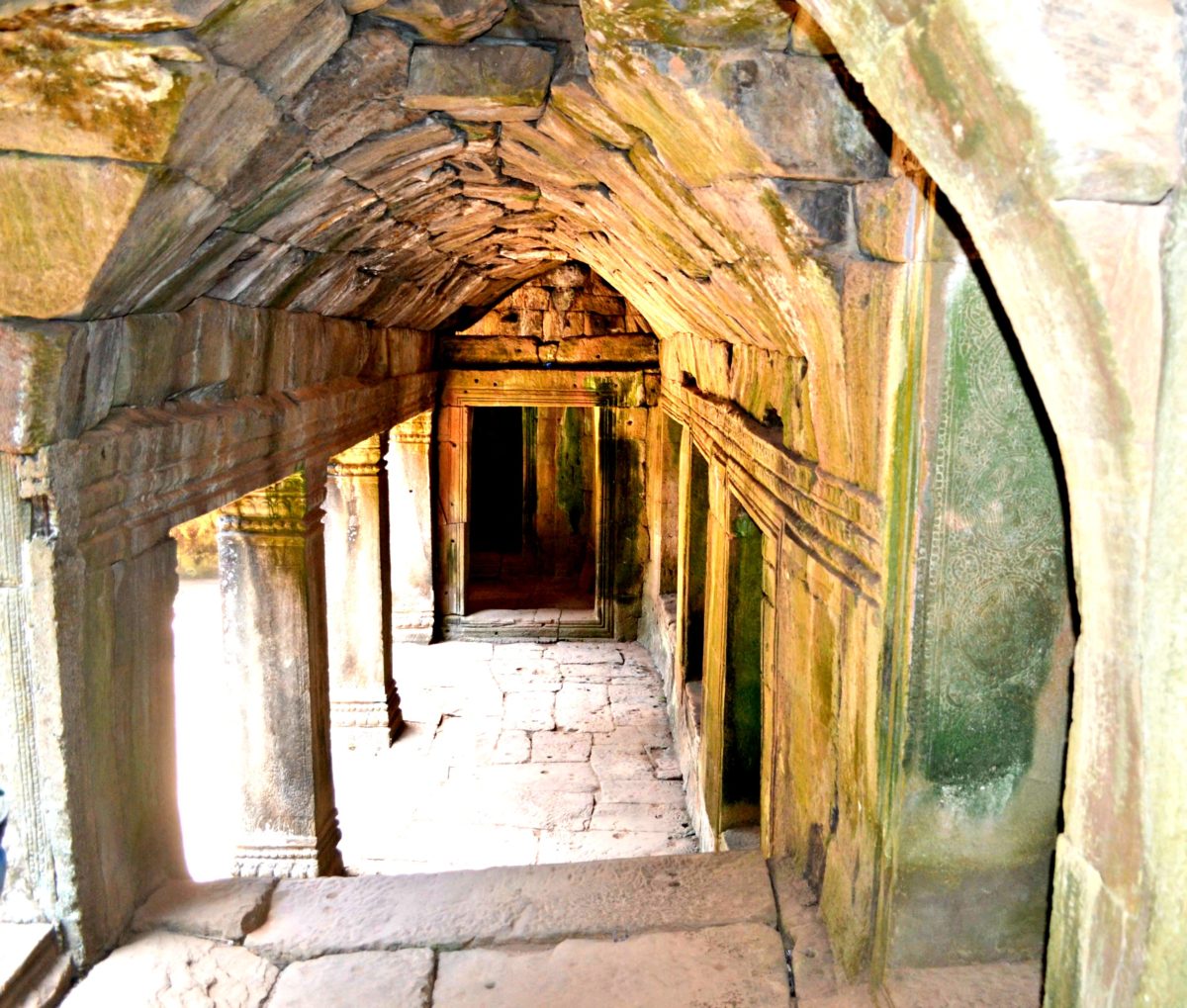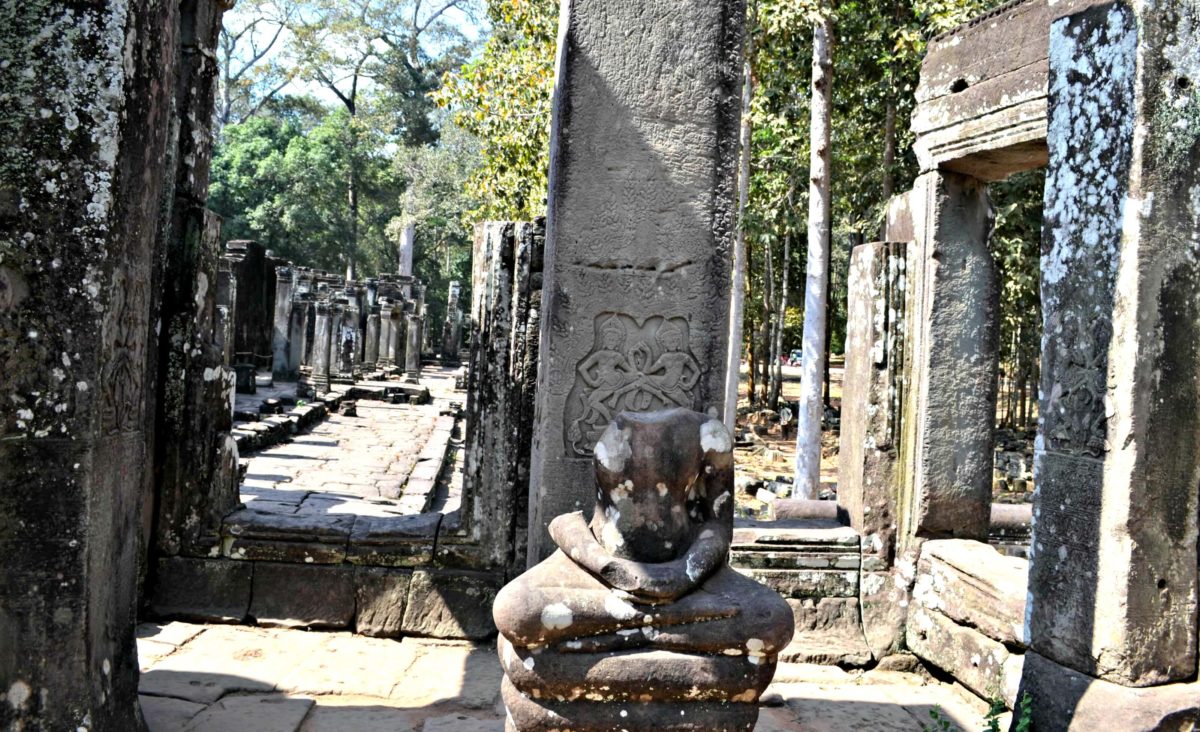It was a sunny morning in Siem Reap. After much of bargaining with the tuk-tuk driver, we finally started off to see the Khmer empire. Little did I know about Bayon or any other temple. At first, it looked like I was entering some top-notch university campus. Rows of trees, neatly arranged, lined up on both sides of a large road, and lush green grass carpeted the ground beneath the trees.
At a distance, the moat around the Bayon temple looked like a huge lake. Tourists were already scattered around the monuments, with guides and guide books in hand – inspecting the sculptures, looking at the stupendous structures and being transfixed by the sheer opulence and the beauty.

If you enter from the east, the first structure that comes in your way is the world’s largest monument in the world, Angkor Wat temple, a renowned UNESCO world heritage site. This magnificent structure needs another post entirely. Further ahead, the road will lead you to the ancient capital city of Angor Thom. Yes, there lies a city itself. And it’s not your typical city. It’s considered to be one of the grandest capital cities ever known to humanity.
The grandeur exuded by this town even to this day, with just the boulders of stones is unparalleled. It’s long walls, which fortifies the city in the form of a perfect square, runs for five miles. At the time of its zenith period, it housed a large Royal Palace, hundreds of houses, temples, gardens and pavilions – a city so enormous and effulgent that many historians believe it hard to comprehend and decipher even to this day.
A full view of the majestic Bayon temple, standing between the trees greets you. You enter the temple from the east, climbing the stairs. The structure has so many layers of monuments at different levels that at first, it looked like I’d landed in the midst of mighty stones. But as I walked through – the magnificence of the Bayon temple exuded. The large rubble enriched with intricate figurines lying around embodies the grandeur of the Khmer empire.

The first thing that gets you hooked is the huge faces. Especially, your eyes cannot miss the enigmatic smile, and before you know, a smile would be formed on your face as well. The broad forehead, half-closed eyes, the long nose with slightly flared nostrils, and the curled lips – that emanate a dazzling smile, evokes contentment and bliss.

I was captivated by the power of this unruffled smile, like the other travelers. It was like having a wordless conversation amidst the dense jungle, with nature, with a glorious past. The smile is consummate – it is perfect and poised. As you explore the temple, sometimes you come under the direct gaze of these smiling faces, and when you suddenly look from between the galleries, you get a few occasional glimpses of these hovering faces beaming.
Finally, you come close enough, standing right in front of those faces – they look towering over you, and the smile cannot get anything less than the best. I’d never seen a smile ever so imposing and elegant.
These faces have been constructed without the help of cement or mortar – which means these have been built by placing perfectly symmetric carved rocks to form a monumental visage. It was calculated that there were 54 towers with more than 200 such faces, although 37 towers remain today. Encountering these bright faces is a fascinating experience, which makes the Bayon temple stand apart.

Who was this man with the most pleasant smile? Well, it is believed to be that of Avalokiteshvara, the Bodhisattva of compassion. However, historians believe it to be the face of the Khmer King Jayavarman VII, the highly coveted Emperor. This theory finds a substantial basis, as he constructed the Bayon temple and made it the state temple during his reign.
A staunch believer of the Buddhist principles, he’d made Buddhism the state religion during his reign. He presumed him to be the God-King ruling upon his people and insisted on influencing his omnipresence by constructing faces resembling him, throughout Angkor Thom.

Being a king is all about being powerful. Isn’t it? In the history of any part of the world, one can notice that it’s about orchestrating the dominance and affecting the lives of the ordinary people. A passion for becoming God in the eyes of his people – to be worshipped, feared and respected.
It’s a subtle way of ruling not just the city, but the minds of the citizens. It is what probably the most powerful kings of the kingdoms thought throughout the history of times. If not for the Kings, how could pomp and the glory exist and define the spirit of the dynasties?

Looking at the history of the Bayon temple:
Here are some of the interesting facts of this temple and the capital city of Angkor Thom that I got to know from our guide and the guide book ‘Ancient Angkor’:
1. Angkor Thom is believed to be the most populated capital city in the medieval times, between the 12th and 14th centuries. It’s estimated that more than 1 million people lived in this fortified town – in houses made of wood and stones.
2. A moat with water, which is now dry, forms the circumference of this city. The water in the canal was 80 feet deep, and the gates were an engineering marvel, making the city almost impossible to penetrate. Five gates had causeways before them. The most popular is the South gate, the one that you get as you pass through Angkor Wat.
Tall structures of 54 Asuras and 54 Devas holding the giant serpent – a scene depicting the ‘Samudra Manthan’ or the churning of the sea of the milk can be seen. The grimacing faces of the Asuras or the demons are so realistic that they intrigue the travelers.

While the almond eyes of the gods speak of goodness, the dilated round eyes of the Asuras symbolises the demons. It is known that two golden lions guarded the gates at each end of this city.
Most of these are the replicas. Some of the original structures were stolen, and few of them are in the National Museum. These are popularly called as ‘Naga Gates’ by the locals.
The tower on the gate consists of the smiling faces and the sculpture of Indira, along with a three-headed elephant. It symbolises the gateway to the paradise, headed by its King Indira, which welcomes the visitors.

3. The Bayon temple is exactly at the centre of the city of Angkor Thom. The Khmers considered the connection between the earth and heaven. It is assumed that this is the reason why no walls, moat or a fort surrounds this temple, as the temple itself was considered a gateway for the mortal human beings – to transcend to heaven in this life?
Also, as the entrance depicts the churning of the sea, where is Mount Mandara, the epicentral mountain of this churning? Archaeologists believe that the Bayon temple itself represents the mountain.
While this theory propels from Hinduism, another philosophy is that the central tower signifies Mount Meru, the cosmic mountain, and the temple is considered a microcosm of the universe according to Buddhism.
4. A lotus tower, entirely made of gold, stood at the centre, at several feet high. It housed a statue of the Bodhisattva, which was taken away by the succeeding kings. The temple later became an abode of the Hindu Gods – with the idols of Vishnu, Brahma and Shiva being prominently worshipped.

5. Brahmin priests from India performed the rituals in this temple when Hinduism prevailed, and they held a revered position in the Khmer society.
6. The bas-reliefs on the walls surrounding the temple consist of more than 11,000 sculptures – each of them intricately carved, depicting a story of its own. Each of this stone weighs more than 300 kg!
7. The Goddess of beauty, Apsara is of great importance to the Khmer empire. You can find the incredible sculptures of these Apsaras dancing.
8. The bas-reliefs consist of figurines depicting the battle of Khmer with Cham ( which is today’s Vietnam) – you can even find the enemies being thrown into the water, to the crocodiles. Many scenes illustrate the lives of the Khmer people in Angkor Thom.

The Angkor Wat is unusual, but Bayon temple will remain my favourite – because, it is wild, enigmatic and rustic. It exhilarates the charisma of a lost kingdom, and the smiling faces – well, the aura of the smile will remain fresh in my memories for a long time.
Have you been to this temple? What are your fond memories?
Loved my post? You can subscribe to my posts by email.
You can also follow my stories on Facebook, Twitter, and Instagram.
- Your Ultimate Guide to the Best Things To Do in Krakow, Poland - April 12, 2024
- Exploring the Hidden Gems of European Ski Resorts - March 28, 2024
- 25 Beautiful Landmarks In Poland For Your Bucket List - March 16, 2024



